Readers familiar with the TV series ( and, of late, the multi-media phenomenon ) ‘Doctor Who‘ will recall 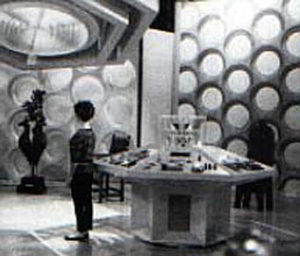 this plaintive cry of astonishment, from countless visitors to the Doctor’s TARDIS. That’s ‘Time And Relative Dimensions In Space’, just to show that I watched this programme, avidly, from the seventies onwards ( see image, left, from its very first 1960s story-line ). Yes, the Time Lord’s Police Box machine is indeed ‘bigger on the inside’ and, unlike its predecessor, H.G.Wells’ ‘The Time Machine‘ it travels through space as well as time and accommodates more than one traveller.
this plaintive cry of astonishment, from countless visitors to the Doctor’s TARDIS. That’s ‘Time And Relative Dimensions In Space’, just to show that I watched this programme, avidly, from the seventies onwards ( see image, left, from its very first 1960s story-line ). Yes, the Time Lord’s Police Box machine is indeed ‘bigger on the inside’ and, unlike its predecessor, H.G.Wells’ ‘The Time Machine‘ it travels through space as well as time and accommodates more than one traveller.
Imagine my amazement then, when I moved into my current home in South London, to find exactly such a machine, complete with flashing blue light, in my neighbour’s garden. Over the years I have seen many young folk enter it, rain or shine, to travel on the wings of their imaginations into other dimensions entirely. It is always a talking point too. Only recently, as I stood in my own garden, I watched a builder, working on a different neighbour’s house, scale the front of the roof only to stand up at its apex and shout down to his mates in the road ‘There’s a TARDIS in that garden!’ Very much a shared cultural reference point.
a machine, complete with flashing blue light, in my neighbour’s garden. Over the years I have seen many young folk enter it, rain or shine, to travel on the wings of their imaginations into other dimensions entirely. It is always a talking point too. Only recently, as I stood in my own garden, I watched a builder, working on a different neighbour’s house, scale the front of the roof only to stand up at its apex and shout down to his mates in the road ‘There’s a TARDIS in that garden!’ Very much a shared cultural reference point.
Sadly, this summer, the TARDIS is leaving. I am assured, its previous occupants having grown out of it, (is that possible?), that it is visiting some new, younger travellers who will appreciate its properties rather more. Thus it’s own physical dimensions are changing – it’s being dismantled. It’s hard not to read this as the dismantling of childhood (mine as well as the neighbours’), but then, putting away childish things was always poignant and it is but a box.
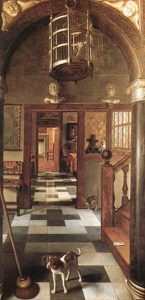 Boxes, dimensions and infinity seem to be something of a theme this year (or maybe they always are and I just haven’t noticed). A second magical box, Samuel van Hoogstraten’s ‘Peepshow’ figured in my short story ‘A Changing Sky‘ (see Reader’s Club page). This seventeenth century magic box can be found in the National Gallery, London, in the Dutch rooms. It is a wooden box, painted with allegorical scenes of wealth and fame, on the outside. But, when you look though the peephole in one side you see the interior of a house, with corridors branching off into other rooms, where people sit, and you even see the scene beyond the window. The box is bigger on the inside!
Boxes, dimensions and infinity seem to be something of a theme this year (or maybe they always are and I just haven’t noticed). A second magical box, Samuel van Hoogstraten’s ‘Peepshow’ figured in my short story ‘A Changing Sky‘ (see Reader’s Club page). This seventeenth century magic box can be found in the National Gallery, London, in the Dutch rooms. It is a wooden box, painted with allegorical scenes of wealth and fame, on the outside. But, when you look though the peephole in one side you see the interior of a house, with corridors branching off into other rooms, where people sit, and you even see the scene beyond the window. The box is bigger on the inside!
It isn’t of course, it’s just van Hoogstraten’s very, very clever use of precise perspective to trick the brain and the eye. He wrote all about pictorial persuasion and illusionism in his magnum opus ‘Introduction to the Academy of Painting or The Visible World‘ (Rotterdam, 1678). For a more modern, practical discussion, I suggest that you watch the National Gallery podcast with Professor Phillip Steadman, who references the TARDIS. Incidentally, the image above by Van Hoogstraten is not from the box, but it shares some features with it.
More recently I came across another ‘perspective box’, Yayoi Kusama’s ‘Passing Winter‘ currently on 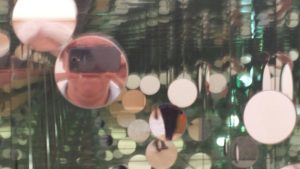 show at the Switch House, Level Two, Tate Modern (see The Switch House ). This fragile thing is a mirrored box with a number of peepholes in its sides. When the viewer looks into one he or she looks on to another set of mirrors, which reflect themselves, the peepholes and the viewer into infinity (see right).
show at the Switch House, Level Two, Tate Modern (see The Switch House ). This fragile thing is a mirrored box with a number of peepholes in its sides. When the viewer looks into one he or she looks on to another set of mirrors, which reflect themselves, the peepholes and the viewer into infinity (see right).
A similar, but different, trick happens in Doug Aitken’s ‘Twilight‘ (2014) installed in the ‘Daydreaming with Stanley Kubrick‘ exhibition at Somerset house. 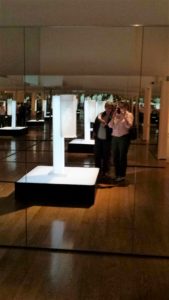 Here the viewer is inside the equivalent of the box, next to a luminous payphone, which references the payphone in ‘Dr Strangelove‘ upon which our hero attempts to avert nuclear war. Mirrored surfaces all around show the phone and the viewers,
Here the viewer is inside the equivalent of the box, next to a luminous payphone, which references the payphone in ‘Dr Strangelove‘ upon which our hero attempts to avert nuclear war. Mirrored surfaces all around show the phone and the viewers, 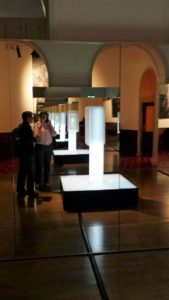 receding into infinity. This is all complicated further by the architecture of Somerset House, its long arched corridors adding to the impression of infinite recession.
receding into infinity. This is all complicated further by the architecture of Somerset House, its long arched corridors adding to the impression of infinite recession.
Now the TARDIS in the garden has had its doors removed it is possible, of course, to see inside. Those blue interior walls are just so disappointing. Not, however, to its new owners, I hope. The creative corridors of the mind are indeed infinite.
If you enjoyed reading this article you might also enjoy Switch House Exhibits Georgia O’Keeffe Art


 RSS – Posts
RSS – Posts